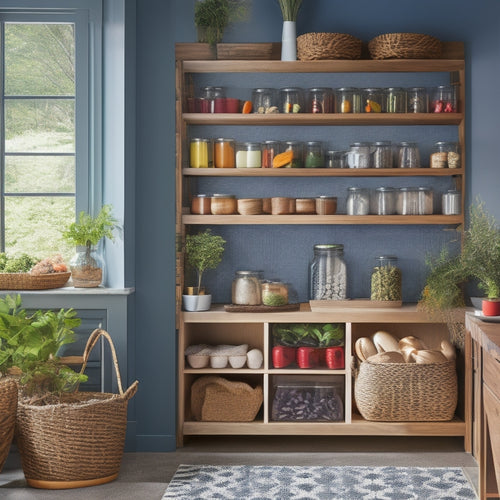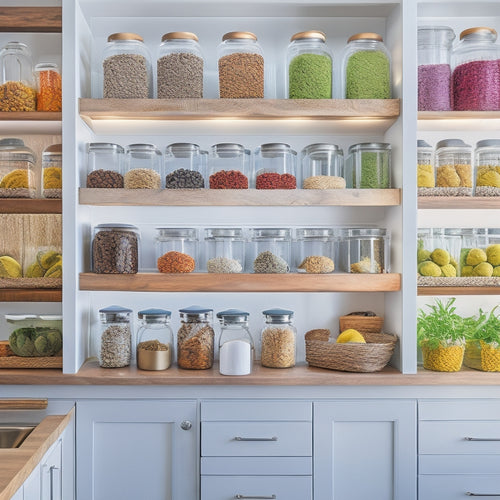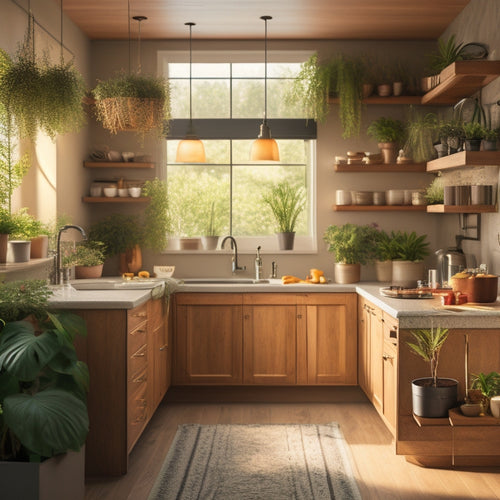
Why Small Kitchen Islands Need a Decluttering Plan
Share
You need a decluttering plan for your small kitchen island because its limited space demands intentional organization to remain functional and efficient. Start by pinpointing clutter hotspots, evaluating items for necessity and frequency of use, and letting go of unused items. Then, sort items into "donate," "recycle," and "discard" boxes, being ruthless about what to keep. Next, maximize storage space with adjustable shelves and corner carousels, and allocate space efficiently based on task prioritization. A well-planned decluttering strategy will help you create a functional workflow and maintain a clutter-free zone. Now, discover how to tailor this approach to your unique kitchen needs.
Key Takeaways
• Small kitchen islands require decluttering plans to prevent clutter accumulation and maintain a sense of openness in the kitchen.
• Cluttered islands hinder workflow and make food preparation more challenging, highlighting the need for a decluttering strategy.
• A decluttering plan helps identify and prioritize frequently used items, allocating space efficiently and promoting a functional workflow.
• Without a plan, small kitchen islands can quickly become overwhelming, making it essential to develop daily habits that promote organization.
• A decluttering plan ensures that each item has a designated home, reducing clutter and promoting a sense of calm in the kitchen.
Identifying Clutter Hotspots First
Identifying Clutter Hotspots First
Start by pinpointing the areas in your small kitchen where clutter tends to accumulate the most, as these hotspots will be your top priorities for decluttering. To do this, take an Island Assessment of your kitchen, paying attention to the countertops, cabinets, and floors.
You'll likely notice Clutter Patterns emerging, such as piles of dirty dishes near the sink or stacks of cookbooks by the stove. Make a mental note of these areas, as they'll require extra attention during the decluttering process.
Take a closer look at the items in these hotspots. Are they essential kitchen tools or mere knick-knacks? Are they frequently used or just taking up valuable space? Be honest with yourself – if you haven't used it in the past year, it's probably safe to let it go.
Purging Unnecessary Items Fast
Now that you've identified the clutter hotspots in your small kitchen, it's time to tackle the items that are taking up valuable space and serving no purpose, starting with the easiest ones to part with.
You'll be surprised at how quickly you can make progress when you focus on purging unnecessary items fast. Speed is key here, as it helps you build momentum and overcome the emotional attachments that can make decluttering challenging.
Begin by gathering three boxes or bins labeled 'donate,' 'recycle,' and 'discard.' Quickly sort items into these categories, being ruthless about what you really need or use regularly.
Maximizing Island Storage Space
With your kitchen decluttered, turn your attention to maximizing the storage space on your small kitchen island, focusing on clever solutions that will keep frequently used items within easy reach. You'll want to make the most of every inch to maintain a sense of openness in your kitchen.
Consider installing island shelves that are adjustable and removable, allowing you to customize your storage needs as they change. These shelves can hold everything from cookbooks to infrequently used kitchen gadgets.
Don't forget about the often-wasted space in the corners of your island. Corner carousels are a great way to utilize this area, providing easy access to spices, oils, or other essentials. They're also a great way to keep countertops clear, maintaining a sense of calm in your kitchen.
Creating a Functional Workflow
To optimize your kitchen's workflow, consider how you move around your island and identify the most frequently performed tasks to determine the most logical placement of essential items. This task prioritization will help you allocate space efficiently, ensuring that the most-used items are within easy reach.
Next, divide your island into zones based on the tasks you've identified. This zone segmentation approach will help you create a functional workflow by grouping similar tasks together. For example, designate a zone for food preparation, another for cooking, and a third for storage.
Within each zone, position essential items in a way that minimizes walking distances and reduces clutter. Place frequently used utensils and ingredients near the zone's center, and store less frequently used items towards the periphery.
Maintaining a Clutter-Free Zone
Set boundaries with your belongings by assigning a home for each item in your kitchen island, making it easier to maintain a clutter-free zone. This is important in preventing clutter from building up again. By doing so, you'll develop daily habits that promote organization and tidiness.
Here are some design principles to keep in mind:
-
Designate a 'launching pad': Choose a specific spot on your island where you'll place essential items, like keys or wallets, to keep them organized and within reach.
-
Utilize vertical storage: Maximize your island's storage capacity by using wall-mounted shelves, hooks, or baskets to keep items off the countertops.
-
Implement a 'one in, one out' policy: Whenever you bring a new item into your kitchen island, get rid of an old one to maintain a balanced amount of possessions.
- Schedule regular tidying sessions: Set aside time each week to maintain your clutter-free zone and make sure that everything remains in its assigned home.
Frequently Asked Questions
Can a Small Kitchen Island Accommodate a Sink or Cooktop?
You'll quickly realize that incorporating a sink or cooktop into your small kitchen island is a challenge due to space constraints and design limitations, making it essential to prioritize functionality and smart layout planning.
How Do I Choose the Right Island Size for My Kitchen?
'Did you know 75% of homeowners consider kitchen islands a must-have? To choose the right size, consider island placement, opting for a shape that complements your kitchen's workflow, and measure carefully to guarantee a comfortable 3-4 feet of clearance around the island.'
Can I Use a Small Kitchen Island as a Dining Table?
You can use a small kitchen island as a dining table, but consider the space savers you'll need to incorporate, like stools or benches, to make meal prep and dining comfortable for your guests.
Are Custom Kitchen Islands Worth the Extra Cost?
You're wondering if a custom kitchen island is worth the splurge? Ironically, it's the opposite of a splurge - it's an investment! With design flexibility, you'll get exactly what you need, and by prioritizing your budget, you'll get it within your means.
How Do I Protect My Island From Water and Heat Damage?
You'll protect your island from water and heat damage by applying sealant options like silicone or epoxy, ensuring a watertight seal. For added damage prevention, install a heat-resistant surface and maintain regular cleaning habits to prevent scratches and spills.
Related Posts
-

Sliding Pantry Storage Ideas for Renters
If you're looking to optimize your rental kitchen, sliding pantry storage solutions could be your answer. Employ vert...
-

Innovative Lazy Susan Storage Solutions
Innovative Lazy Susan storage solutions are a revolutionary advancement for any space, especially in kitchens. They m...
-

Space-Saving Kitchen Island Storage Hacks
You can change your small kitchen into a functional haven with clever space-saving island storage hacks. Start by ins...


